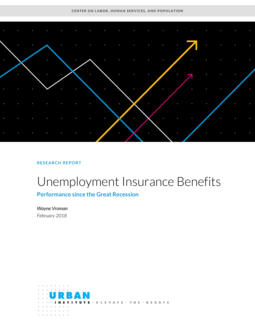Hello! You're looking at a policy document report on Overton
We track government policy, guidelines, think tank research, working papers and more to help our customers see the impact and influence of their work. Are you interested in seeing what information we have to offer? Request a free trial to our platform.
If you fund, produce or manage research or work to influence policy, we'd love to talk. Learn more on our homepage.

Unemployment Insurance Benefits
Wayne Vroman
This paper examines the recent decline in the benefit recipiency rate for state unemployment insurance (UI) programs (i.e., UI beneficiaries as share of total unemployment). From 2012 to 2016, the average benefit recipiency rate was about 25 percent below its average from 2004 to 2007. Three factors contributed to the reduced recipiency rate: (1) several states have shortened the maximum potential duration of benefits below 26 weeks, which has reduced average actual benefit duration; (2) state UI administrative decisions related to continued benefit eligibility have increased the number of beneficiary disqualifications; and (3) average unemployment duration has increased since 2008, increasing the number of people exhausting UI benefits and reducing the recipiency rate.
Topics in this document
Unemployment benefits
Regression analysis
Statistics
Recession
Great Recession
Labour economics
United States
Standard error
Economy
Unemployment
Employment
Linear regression
Dummy variable (statistics)
Errors and residuals
Economics
Mean
Dependent and independent variables
Percentage
Insurance
Urban Institute
Related SDGs
SDG 8: Decent Work and Economic Growth ...
SDG 8: Decent Work and Economic Growth
Target 8.5
Achieve full and productive employment and decent work for all women and men, including for young people and persons with disabilities, and equal pay for work of equal value
Citations
Cited by 5
other policy documents
(3 of them are from other policy sources)
